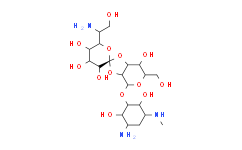| DC31079 |
PPI149
|
Abarelix is a synthetic decapeptide and antagonist of naturally occurring gonadotropin-releasing hormone (GnRH). Abarelix directly and competitively binds to and blocks the gonadotropin releasing hormone receptor in the anterior pituitary gland, thereby inhibiting the secretion and release of luteinizing hormone (LH) and follicle stimulating hormone (FSH). In males, the inhibition of LH secretion prevents the release of testosterone. As a result, this may relieve symptoms associated with prostate hypertrophy or prostate cancer, since testosterone is required to sustain prostate growth. |
| DC31078 |
Asulam
|
Asulam is a wild oat herbicide used in prairie regions for control of wild oats in cereal grains such as wheat. |
| DC31077 |
L-Leucic acid
|
Leucic acid, L- is a metabolite of the branched-chain amino acid leucine. It is commonly sold as a purported muscle building supplement. It also has fungicidal properties. HICA was shown to increase protein synthesis and muscle mass in rats who were recovering from a period of induced atrophy. |
| DC31076 |
Diisononyl phthalate
|
Diisononyl phthalate (DINP) is a phthalate used as a plasticizer. DINP is typically a mixture of chemical compounds consisting of various isononyl esters of phthalic acid. |
| DC31075 |
Ditridecyl phthalate
|
Ditridecyl phthalate is a phthalate ester. Phthalate esters are esters of phthalic acid and are mainly used as plasticizers, primarily used to soften polyvinyl chloride. They are found in a number of products, including glues, building materials, personal care products, detergents and surfactants, packaging, children's toys, paints, pharmaceuticals, food products, and textiles. Phthalates are hazardous due to their ability to act as endocrine disruptors. |
| DC31074 |
Isopropyl myristate
|
Isopropyl myristate is the ester of isopropyl alcohol and myristic acid. |
| DC31073 |
L-Butyrine
|
L-Butyrine is a member of the class of compounds known as L-alpha-amino acids. L-alpha-Amino acids are alpha amino acids which have the L-configuration of the alpha-carbon atom. L-alpha-aminobutyric acid is soluble (in water) and is a moderately acidic compound (based on its pKa). L-alpha-Aminobutyric acid is a non-proteogenic amino acid that can be found in the human kidney, in liver tissues, and in most biofluids or excreta (e.g. feces, breast milk, urine, and blood). Within the cell, L-alpha-aminobutyric acid is primarily located in the cytoplasm. alpha-Aminobutyric acid is biosynthesized by transaminating oxobutyrate, a metabolite in isoleucine biosynthesis. As a non-proteogenic amino acid, alpha-aminobutyric acid can be used by nonribosomal peptide synthases. One example of a nonribosomal peptide containing alpha-aminobutyric acid is ophthalmic acid, which was first isolated from calf lens. alpha-Aminobutyric acid is a non-essential amino acid that is primarily derived from the catabolism of methionine, threonine, and serine. High protein diets can result in significantly higher alpha-aminobutyrate levels in plasma (PMID: 26227325 ). alpha-Aminobutyric acid is elevated in the plasma of children with Reye's syndrome, tyrosinemia, homocystinuria, nonketotic hyperglycinemia, and ornithine transcarbamylase deficiency (PMID: 420125 ). alpha-Aminobutyric acid is one of the three isomers of aminobutyric acid. The two other are the neurotransmitter gamma-aminobutyric acid (GABA) and beta-aminobutyric acid (BABA) which is known for inducing plant disease resistance. |
| DC31072 |
Amino-PEG8-alcohol
|
Amino-PEG8-alcohol is a PEG derivative containing an amino group with a hydroxyl group. The amino group is reactive with carboxylic acids, activated NHS esters, carbonyls (ketone, aldehyde) etc. The hydroxyl group enables further derivatization or replacement with other reactive functional groups. PEG Linkers may be useful in the development of antibody drug conjugates and drug delivery methods. |
| DC31071 |
Prochloraz
|
Prochloraz is a broad-spectrum contact imidazol fungicide used against several diseases in wheat, barley and oleaginous plants but also for treatment of flower production. It is a fungicide known to have multiple effects on the endocrine system of vertebrates. |
| DC75868 |
AZ14133346
|
AZ14133346 (compound 36) is a potent and selective inhibitor of EGFR Exon20 insertions, with the IC50 of 85 nM. AZ14133346 plays an important role in cancer research. |

 DC Chemicals' products qualify for U.S. tariff exemptions. We guarantee no price increases due to customs duties and maintain stable supply, continuing to deliver reliable research solutions to our American clients.
DC Chemicals' products qualify for U.S. tariff exemptions. We guarantee no price increases due to customs duties and maintain stable supply, continuing to deliver reliable research solutions to our American clients.





















